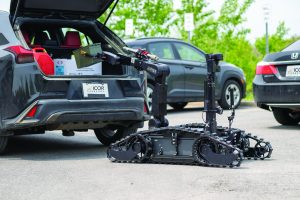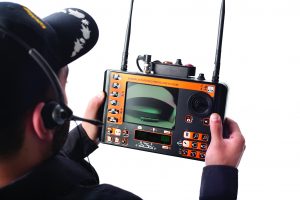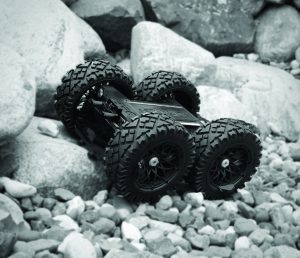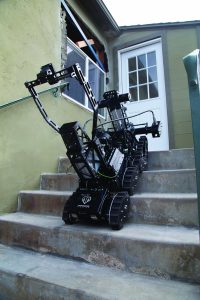At a time when officer wellness is prioritized but Staffing is depleted, agencies must embrace technology to ensure missions are completed safely and effectively.
Recent advancements in robotic technology pose the question: Why expose a human to danger when a robot can go in their place?
Robot Applications
For years, robots were seen only as a nice to have product rather than a must have tool. Upon their first introduction to the policing profession, robots were considered to be useful in tactical situations, but users soon realized the true potential of the technology afforded to them.

When ICOR Technology (ICOR) unveiled its inaugural robot in 2007, public safety agencies predominantly relied on robotics for explosive ordinance disposal (EOD) tasks. Recognizing an opportunity to enhance a SWAT team’s capabilities during barricaded situations, ICOR launched the Mini-CALIBER—a compact, portable robot that excels in a variety of situations. Constructed from high-quality, aircraft grade aluminum, the robot offers rapid deployment, the ability to easily climb stairs, and the functionality to open doors without the need of reconfiguration.
The Mini-CALIBER also features the Mini-Draco gas delivery system. It can remotely and safely initiate two cannisters of gas, separately or together. The high-power blower pushes the gas under doors and other hard to penetrate areas. The gas can be delivered while driving the robot through a structure for full saturation, removing the need to deploy gas rounds through windows.

Today, there has been a shift toward joint operations and enhanced interoperability between SWAT and EOD teams. “But the Mini-CALIBER is not just for tactical and EOD teams,” said ICOR Marketing and Communications Specialist Pawarit Puwarattanakul. “Patrol can use the robot to instantly respond on the street to the many situations where a human response is less than desirable.”1 Ranging between 60 pounds to 750 pounds, ICOR offers five affordable and distinct platforms in the line of CALIBER robots that allow police to remotely manage high-risk, life-threatening situations. As companies release more affordable options, the perception that robots are exclusively for tactical operations has been shifted.
“Traditionally, high costs and specialized designs limited robot use to tactical units,” said Shawn Mahaney, chief executive officer and founder of Tactical R/C.2 These barriers prevented small agencies from realizing the capabilities because many could not justify purchasing robots when they do not have a SWAT team or high callout volume. As seen with rovers like Tactical R/C’s 4Sight, agencies have quickly discovered the broader applications of robots across the policing profession.

During a patrol response to the break-in of an apartment, Mahaney (who was a member of the SWAT team at the time) utilized a compact tactical robot to clear the apartment prior to officers entering. “Officers frequently encounter scenarios where simply having a set of eyes on the other side of the doorway, down a hall, or around a corner can be the difference between safety and tragedy,” said Mahaney. It was from this scenario that Mahaney realized the numerous applications for a robot outside of tactical response. Upon teaming up with Josh Dean, the two developed Tactical R/C’s flagship rover. Since its introduction, the 4Sight has been deployed in several aspects of the job, from patrol, investigations, and mental health crisis units.
The 4Sight is a compact, four-wheeled invertible rover designed to balance capability, durability, and affordability. The 4Sight was designed to get over, around, and through common obstacles, such as clothing and partially opened doors. To handle the rigors of police operations, the rover was built with a carbon fiber body and a 360-degree impact mitigation system, leaving out fragile mechanisms that are prone to breakage. Leveraging existing live-view technology within officer cellphones and body-worn cameras mirror the functionality of traditional robots but at a fraction of the cost.
When Transcend Robotics (Transcend) was founded in 2014, the primary need of a robot was to consist of lightweight equipment and effective stair climbing. Ten years later, the profession’s interest has shifted toward adding unique capabilities that give officers the most utility on a per callout basis. “In 2024, officers should not have to speculate about a suspect’s location and unnecessarily place themselves and the suspect in harm’s way,” said Eric Habeeb, head of local and state law enforcement sales at Transcend.3 To avoid these situations, Transcend designed three robot variations with unique mission-specific capabilities.

The Vantage Robot is the flagship system. The Vantage’s comprehensive camera suite provides optimal situational awareness as the operator maneuvers it through unknown territories with a simple joystick. The payload bed with bungee hookups and screws for accessories is capable of carrying up to 400 pounds. A two-way communication allows officers to speak with subjects near the robot. All these features are available in the Mini-Vantage Robot, which is 18 inches long and under 5 pounds. The smaller version was developed in response to officer requests for a more agile option that can be tossed in vents, through crawl spaces, or down a flight of stairs.
Transcend makes an optional safe indoor hot gas delivery system that can be added to the Vantage Robot to safely encourage non-compliant subjects to vacate a building. The system encases the flame to reduce potential fire hazard and gives officers the ability to deploy nonlethal gas precisely when and where they need it.

The Breacher Robot addressed the critical need for remote access through locked or barricaded doors. Before the Breacher Robot, police had to manually bash doors open, exposing themselves to threats. “Countless incidents documented officers being fatally shot through doors during breaches or left vulnerable in what’s grimly referred to as the ‘hallway of death,’” said Habeeb. With limited options, agencies would resort to expensive robotic arms or explosive breaching tactics, which did not always provide a safer or more effective solution. The Breacher Robot has 9,000 pounds of spreading force and 2,000 pounds of push force to get through almost any locked door or barricade.
Both the Breacher and Vantage Robots have a continuous runtime of 3 hours and can sit idle for up to 12 hours. They are powered by Transcend’s patented joint technology that provides the needed force to more easily climb stairs and overcome other typical obstacles.
Future Advancement
The policing profession has evolved significantly within the last decade, requiring constant calls to adapt and find innovative uses of the available technology. For instance, although it contains the best features of previous models, the smartest robot in the ICOR CALIBER family is the CALIBER FLEX, which was designed to evolve with advancing technology. This means that it can adapt and integrate new features and capabilities as technological innovations emerge. Agencies have also found success in integrating robots and drones into cohesive tech programs. Transcend’s Breacher Robots is often accompanied by a DJI Avata Drone for its advantageous aerial perspectives.
“Ground robotics represent pivotal advancements in life-saving technology for first responders,” said Puwarattanakul. “Introducing these tools into high-risk events equips command teams with crucial situational awareness.” With affordable robotic options, access to the technology has been broadened, and a safer, more versatile tool has been added to the police officer’s toolbox.d
Notes:
1Pawarit Puwaranttanakul (marketing and communications specialist, ICOR Technology), email interview, July 4, 2024.
2Shawn Mahaney (CEO/founder, Tactical R/C), email interview, July 2, 2024.
3Eric Habeeb (head of local and state law enforcement sales, Transcend Robotics), email interview, July 8, 2024.
Source ListPlease click on the companies’ names to go to the companies’ websites. |
|
Please cite as:
“From Luxury to Necessity,” Product Feature, Police Chief 91, no. 8 (August 2024): 58–60.


